Related Research Articles
Punk rock is a music genre that emerged in the mid-1970s. Rooted in 1950s rock and roll and 1960s garage rock, punk bands rejected the corporate nature of mainstream 1970s rock music. They typically produced short, fast-paced songs with hard-edged melodies and singing styles with stripped-down instrumentation. Lyricism in punk typically revolves around anti-establishment and anti-authoritarian themes. Punk embraces a DIY ethic; many bands self-produce recordings and distribute them through independent labels.
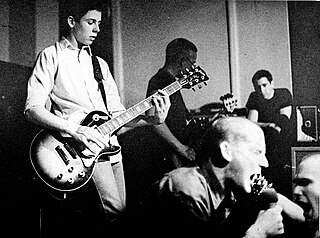
Hardcore punk is a punk rock subgenre and subculture that originated in the late 1970s. It is generally faster, harder, and more aggressive than other forms of punk rock. Its roots can be traced to earlier punk scenes in San Francisco and Southern California which arose as a reaction against the still predominant hippie cultural climate of the time. It was also inspired by Washington, D.C., and New York punk rock and early proto-punk. Hardcore punk generally eschews commercialism, the established music industry and "anything similar to the characteristics of mainstream rock" and often addresses social and political topics with "confrontational, politically charged lyrics".

CBGB was a New York City music club opened in 1973 by Hilly Kristal in the East Village in Manhattan, New York City. The club was previously a biker bar and before that was a dive bar. The letters CBGB were for Country, Bluegrass, Blues, Kristal's original vision for the club. But CBGB soon emerged as a famed and iconic venue for punk rock and new wave bands, including Ramones, Dead Boys, Television, Patti Smith Group, Blondie, Madonna and Talking Heads.

Noise rock is a noise-oriented style of experimental rock that spun off from punk rock in the 1980s. Drawing on movements such as minimalism, industrial music, and New York hardcore, artists indulge in extreme levels of distortion through the use of electric guitars and, less frequently, electronic instrumentation, either to provide percussive sounds or to contribute to the overall arrangement.
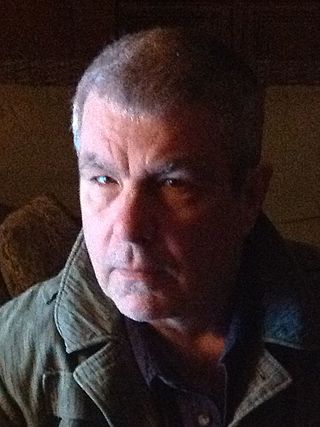
George Lawrence Petros is an American art designer, author, editor, interviewer and illustrator. From 1984 through 1992 he published and edited EXIT, a punk-inspired art and science fiction magazine he founded with Adam Parfrey and Kim Seltzer. From 1992 through 2000 he edited and art-directed Seconds, an all-interview music and culture magazine founded by Steven Blush. From 2000 through 2005 he was a contributing editor of Juxtapoz, the low-brow art magazine founded by Robert Williams, and the senior editor of Propaganda, a goth/industrial music and style magazine founded by Fred H. Berger. He is the author of Art That Kills: A Panoramic Portrait of Aesthetic Terrorism 1984-2001, The New Transsexuals: The Next Step In Human Evolution, and the editor of American Hardcore: A Tribal History.

Bad Brains is the first studio album by American rock band Bad Brains. Recorded in 1981 and released on the cassette-only label ROIR on February 5, 1982, many fans refer to it as "The Yellow Tape" because of its yellow packaging.
Life's Blood was an American hardcore punk band formed by four first-year college students in New York City in 1987. It consisted of Adam Nathanson on guitars, Neil Burke on bass, John Kriksciun on drums, and Combined Effort all ages shows promoter and fanzine editor Jason O'Toole on vocals.

American Hardcore: The History of American Punk Rock 1980–1986 is a documentary directed and produced by Paul Rachman and written by Steven Blush. It is based on the 2001 book American Hardcore: A Tribal History also written by Blush. It world premiered at the 2006 Sundance Film Festival and was released on September 22, 2006 on a limited basis by Sony Pictures Classics. The film features some early pioneers of the hardcore punk music scene including Bad Brains, Black Flag, D.O.A., Minor Threat, Minutemen, SSD, and others. It was released on DVD by Sony Pictures Home Entertainment on February 20, 2007.

Open Your Eyes is the second full-length album from New York hardcore band Warzone. It was released in 1988 on Caroline Records, a year after their first album, Don't Forget The Struggle, Don't Forget The Streets.

Danny Fields is an American music manager, publicist, journalist, and author. As a music industry executive from the 1960s to the 1980s, he was one of the most influential figures in the history of punk rock. He signed and managed Iggy and the Stooges, signed the MC5 and managed the Ramones, and worked in various roles with Jim Morrison, the Velvet Underground and the Modern Lovers. In 2014 The New York Times said, "You could make a convincing case that without Danny Fields, punk rock would not have happened."

Manic Compression is the second studio album by American post-hardcore band Quicksand. It was first released on February 24, 1995 on vinyl through Revelation Records, before being given a widespread CD release through Island Records on February 28, 1995. The album influenced many post-hardcore and alternative metal bands. It peaked at number 135 on the Billboard 200.

James Drescher, better known as Jimmy G or Jimmy Spliff, is the lead singer for New York based hardcore punk band Murphy's Law.
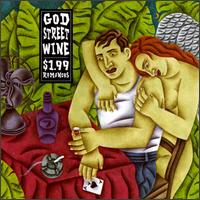
$1.99 Romances is an album by God Street Wine. It was their first release on a major record label and their only release with Geffen.
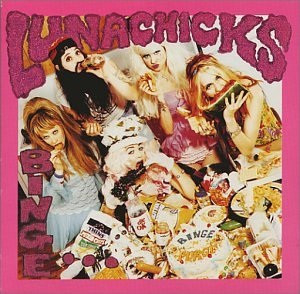
Binge & Purge is the second studio album by the American punk band the Lunachicks. It was released in 1992 via Safe House. The album was produced by Mason Temple along with the band. The album was recorded at SST, Weehawken, NJ, mixed at Quad Recording, NYC, and mastered at MDI, Toronto.
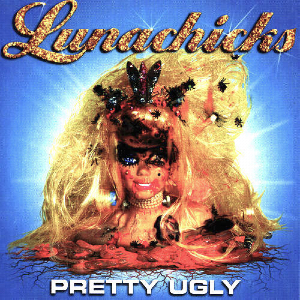
Pretty Ugly is the fourth studio album by the American punk rock band Lunachicks. It was released by Go-Kart Records in 1997.
The Stimulators were an American punk rock band from New York City. Although they have a limited discography, they are notable for being consistently cited as an important transitional band between the late-1970s New York City punk rock scene and New York hardcore, and for being the musical entry point for future Cro-Mags founder Harley Flanagan.

Craig Setari is an American musician who is the bass player of the hardcore punk band Sick of It All. He has also worked with many other hardcore bands, including Youth of Today, Straight Ahead, Rest in Pieces, Agnostic Front and Cro-Mags. Alongside Dan Lilker, he recorded the Noise for Noise's Sake demo tape under the name Crab Society. This demo tape inspired Lilker's band S.O.D. to record their 1985 demo album titled Crab Society North.

Straight Ahead was an American straight edge hardcore punk band formed in Queens, New York City in 1984 by drummer and vocalist Tommy Carroll, guitarist Gordon Ancis and bassist Tony Marc Shimkin.

Susan Marie Beschta, who performed as Susan Springfield, was the founder and lead singer of Erasers, a band that headlined at CBGB in the 1970s.
Erasers was an American punk rock band active in New York City in the 1970s, often playing at CBGB. It was founded by singer and guitar player Susan Springfield and drummer Jane Fire in mid 1970s. Several other musicians played with the band over the years, including bassist Jody Beach, guitarist Richie Lure and David Ebony. They recorded two songs, produced by Richard Lloyd: "I Won't Give Up" and "(It Was So) Funny ". "Funny" was released in 1982 on the ROIR compilation Singles: The Great New York Singles Scene, and in 2015, both songs were released on Ork Records: New York, New York. The name of the band comes from the 1953 novel of the same name by Alain Robbe-Grillet.
References
- ↑ Paz, Eilon (September 1, 2009). "Steven Blush – NY, NY". Dust and Grooves. Retrieved August 4, 2017.
- 1 2 Richman, Alan (March 6, 2017). "Author Steven Blush connects rock 'n' roll with Jewish experience". New Jersey Jewish News . Retrieved August 5, 2017.
- 1 2 3 4 5 6 Friedman, Michael (April 20, 2016). "The Secret of Steven Blush's Success – A new definition of 'rock star'". Psychology Today . Retrieved August 4, 2017.
- ↑ Friedman, PhD, Michael (October 4, 2016). "Steven Blush's Guide to Being The Underdog". HuffPost . Retrieved August 5, 2017.
- 1 2 3 4 5 6 7 Bergen, Marissa (October 31, 2016). "Spotlight On Local: Author Steven Blush: Saving Rock N' Roll, One Book At A Time". Geeks of Doom. Retrieved August 4, 2017.
- 1 2 Datre, Angela (July 19, 2017). "10 Questions with Author Steven Blush". How We Are. Retrieved August 4, 2017.
- 1 2 Moldy (July 19, 2002). "Steven Blush – American Hardcore [book] (2001)". Punknews.org. Retrieved August 5, 2017.
- ↑ Mamone, Jordan N. (January 15, 2002). "No Trend Didn't Just Go Against the Grain, They Shoved It in the Faces of the Pretentious Hardcore Fans". New York Press . Retrieved August 8, 2017.
- ↑ Pajot, S. (January 7, 2011). "American Hardcore's Steven Blush Talks the Middle Class, Youth Culture, and Loud Fast Riffs". Miami New Times . Retrieved August 9, 2017.
- 1 2 3 Flicker, Jonah (November 17, 2010). "Rock and Roll Archaeology: Steven Blush & American Hardcore". Blurt . Retrieved August 4, 2017.
- ↑ "New York Rock: From the Rise of the Velvet Underground to the Fall of CBGB". Publishers Weekly. October 2016. Retrieved August 5, 2017.
- ↑ Hood, John (January 12, 2011). "NiteTalk: Step Into the Mosh Pit with American Hardcore Author Steven Blush". NBC Miami . Retrieved August 5, 2017.
- ↑ King, C. Richard; Leonard, David J. (August 22, 2014). Beyond Hate: White Power and Popular Culture. Routledge. ISBN 978-1472427496 . Retrieved August 4, 2017.
- ↑ Durbin, Jonathan (May 2005). "A Dangerous Mind". Paper . Retrieved August 8, 2017.
- 1 2 Hutchings, Nick (December 21, 2016). "Steven Blush, Author – Song For Ewe". Velvet Sheep. Retrieved August 4, 2017.
- 1 2 Babayan, Siran (February 3, 2011). ""Hardcore Is a Complete, Legitimate California-born Music Form": An Interview with "American Hardcore" Author Steven Blush, Who Speaks Today at Book Soup with Keith Morris and Others". LA Weekly . Retrieved August 5, 2017.
- ↑ York, William (November 22, 2010). "Historian Steven Blush on Indiana hardcore". NUVO . Retrieved August 5, 2017.
- ↑ Melnick, Jordan (January 11, 2011). "Interview with American Hardcore Author Steven Blush". Beached Miami. Retrieved August 5, 2017.
- ↑ Eakin, Marah (December 2, 2010). "American Hardcore's Steven Blush". The A.V. Club . Retrieved August 5, 2017.
- ↑ Alen, Michael (January 13, 2011). "Interview with Steven Blush author of American Hardcore". The Miami Herald . Retrieved August 5, 2017.
- ↑ McKenzie, Scott (January 17, 2007). "Interview: Steven Blush, Author". slushpile.net. Retrieved August 8, 2017.
- ↑ "Hair Today, Gone Tomorrow". Spin . December 2006. Retrieved August 8, 2017.
- ↑ Pinfield, Matt (May 4, 2017). "104 – 'NEW YORK ROCK' – author Steven Blush, Tony Man, and Faith No More drummer Mike Bordin on the New York scene, Mike's friendship with the late Cliff Burton, and Steven's latest book 'New York Rock'". Westwood One . Retrieved August 5, 2017.
- ↑ Mann, James (October 17, 2016). "New York Rock: From The Rise of the Velvet Underground to the Fall of CBGB". The Big takeover. Retrieved August 4, 2017.
- ↑ "NEW YORK ROCK – From the Rise of the Velvet Underground to the Fall of CBGB". Kirkus Reviews. July 19, 2016. Retrieved August 5, 2017.
- ↑ Bienstock, Hal (October 26, 2016). "Steven Blush's 'New York Rock' chronicles local music scene". AM New York . Retrieved August 5, 2017.
- ↑ DJ Jason (April 8, 2016). "New Music Journalism Book includes the History of the NYC goth". absolution.nyc. Retrieved August 4, 2017.